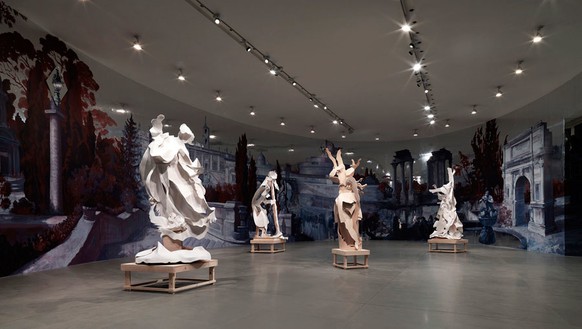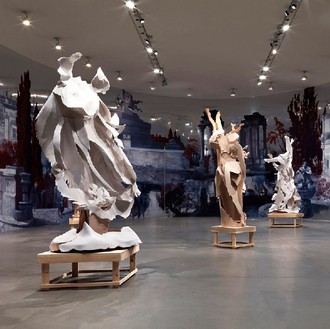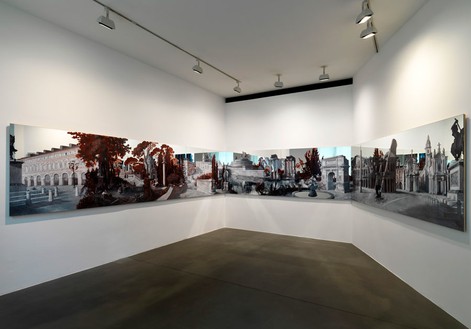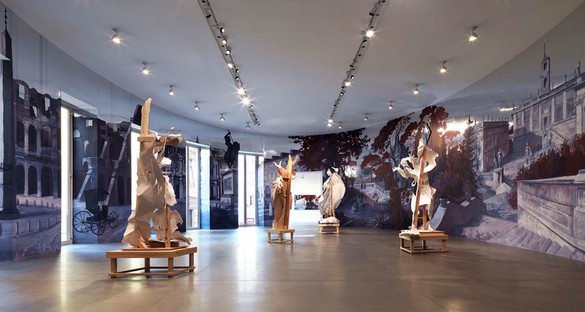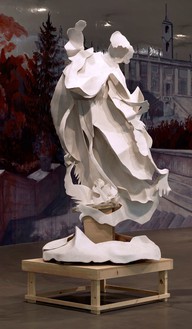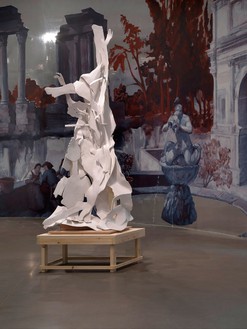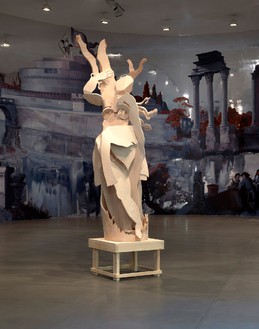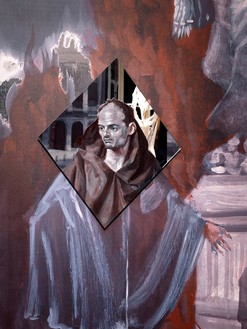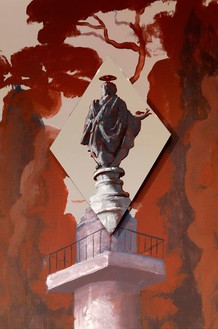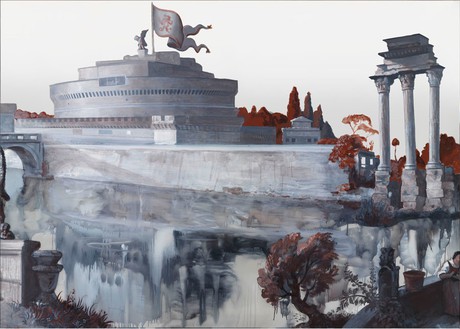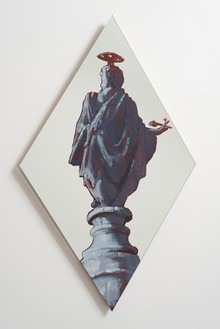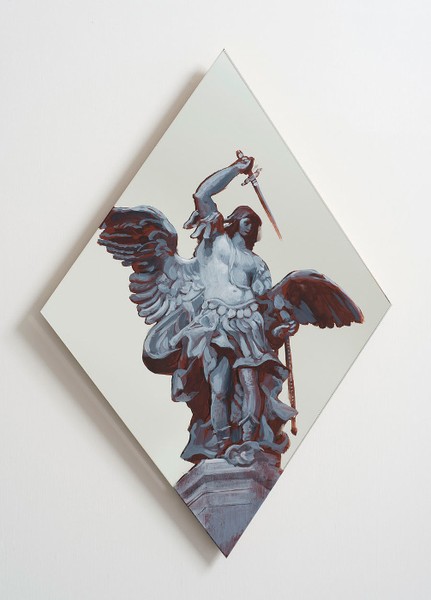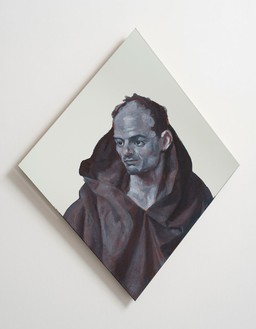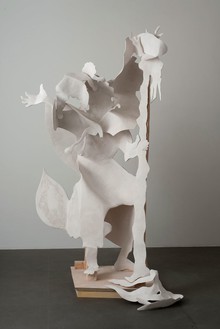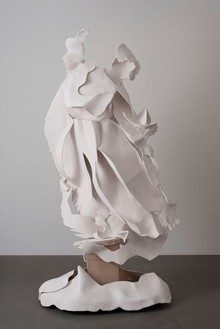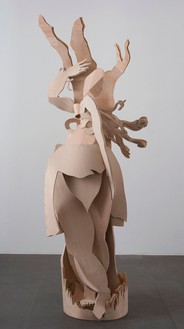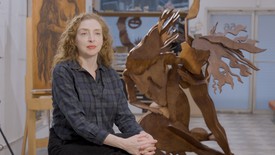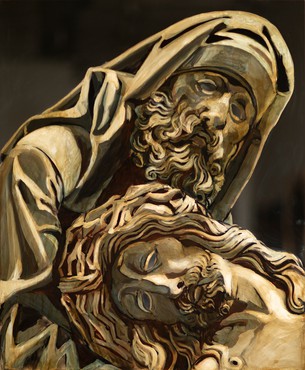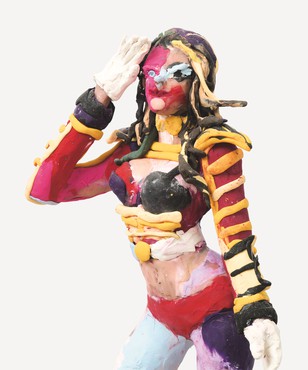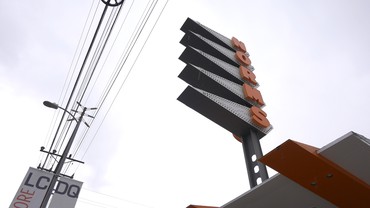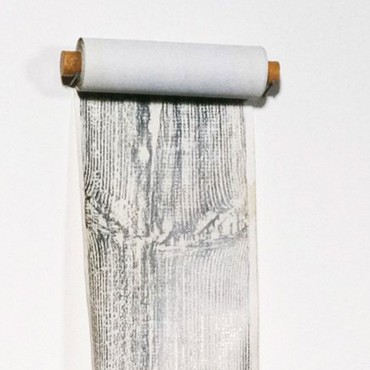About
I'll do a drawing, and then drawings of the drawing, and keep getting away from the source as many times over as I can so I don't just replicate. I'm not interested in trying to copy the object itself. And then sometimes I'll cut up the drawing and hot glue-gun the whole thing into a three-dimensional paper drawing, and either that will become a sculpture on its own—because that weird, flattened, planed-wood sculpture will be really beautiful—or I'll use that as a skeleton, and then I'll add stuff on top.
—Rachel Feinstein
Gagosian Gallery is pleased to present a site-specific installation by Rachel Feinstein. This is her first exhibition in Rome.
Feinstein's multi-part installations, which contain autonomous sculptures and paintings, reveal her singular flair for synthesizing a myriad of cultural fascinations—religion, myth, beauty, mortality, decadence—into vignettes of the marvelous. Oil paintings on mirrored surfaces, flat propped sculptures reminiscent of stage dressings, and abstracted reworkings of classical sculpture confront persistent issues of artistic representation such as theatricality and illusionism. By layering quotations from diverse artistic, architectural, cultural, and stylistic sources—from religious iconography to Baroque sculpture, Romantic landscapes, and popular cartoons—art and history are charged with a burlesque sensibility.
In this latest of her compelling fantasies, Feinstein has covered the interior gallery walls with a panoramic wallpaper of an impressionistic Rome. Sourcing and collaging diverse artistic visions of the city from different historical periods, she first made a large oil painting on mirror depicting this heterotopia of her own invention, where an eighteenth century piazza scene buzzing with life jostles against ancient ruins and an Arcadian landscape. This was then printed on mirrored wallpaper, to which five diamond-shaped glass mirrors, painted with faces, are fixed, merging cunningly with the background panorama while catching and reflecting the passing viewer's gaze.
Prima disegno, poi realizzo altri disegni dal disegno, allontanandomi sempre più dalla fonte per evitare repliche. Non mi interessa copiare l'oggetto in sè. Mi capita anche di tagliare il disegno e ricomporlo tridimensionalmente, in modo che possa diventare una scultura indipendente—perchè la superficie levigata del legno è bellissima-o che venga utilizzato come scheletro su cui aggiungere altri elementi.
—Rachel Feinstein
Gagosian Gallery è lieta di annunciare una installazione site-specific di Rachel Feinstein, la prima mostra dell'artista con la galleria.
Le complesse installazioni di Feinstein sono composte da sculture e dipinti e rivelano la capacità singolare dell'artista di presentare l'ampia gamma dei suoi interessi—dalla religione al mito, dalla bellezza alla mortalità, alla decadenza—racchiudendoli in racconti di fantasia. Attraverso i suoi lavori, tra cui dipinti ad olio su specchio, sculture bidimensionali che richiamano manichini, e reinterpretazioni astratte di sculture classiche, l'artista si confronta con tematiche artistiche ricorrenti, come la teatralità e l'illusionismo. Ispirandosi a diverse fonti stilistiche, architettoniche e culturali, dall'iconografia religiosa alla scultura barocca, dai paesaggi del Romanticismo alle vignette popolari, arte e storia si caricano di sensibilità "burlesque".
Nel suo ultimo coinvolgente racconto presentato a Roma, l'artista ha ricoperto interamente le pareti della sala espositiva ovale con un panorama impressionista della città. Unendo e sovrapponendo immagini da diverse fonti e periodi storici, Feinstein ha dapprima elaborato questa dimensione utopica dipingendola su una superficie multipannello a specchio, dove una piazza settecentesca con paesaggi arcadici e rovine antiche fa da sfondo alla frenetica attività quotidiana. Le stesse immagini sono state poi stampate su carta da parati specchiata, sulla quale volti ed elementi architettonici fanno capolino, dipinti su specchi romboidali.
Quattro sculture di grandi dimensioni, ispirate a santi e martiri della cristianità, dialogano con questa scenografia. Partendo da piccoli modelli di carta, i soggetti sono stati poi trasformati in sculture di legno e resina monocromatica. I loro contorni indefiniti e dinamici ricordano il vigore dell'estetica barocca tipica dell'ambiente romano.
Vi è l'arcangelo Michele, che sconfisse in battaglia il Demonio; Sant'Agata, vergine e martire, simbolo di tenacia, sottoposta a numerose torture per la sua irremovibile fede, tra cui il violento strappo delle mammelle per aver rifiutato le avances di un prefetto romano; San Sebastiano, trafitto da frecce per non aver rinnegato la fede, miracolosamente sopravvissuto, ma successivamente flagellato a morte; e infine San Cristoforo, il santo patrono dei viaggiatori che porta il peso del mondo intero sulle proprie spalle. Le quattro sculture, prive del dettaglio espressionistico che caratterizza le abituali agonie ed estasi, appaiono come ombre, presenze suggestive dei personaggi originari.
Share
Artist
Rachel Feinstein: Mirror
Join Rachel Feinstein in her New York studio as she addresses the genesis of her exhibition Mirror in London and the enduring power of religious iconography.

Jean Pigozzi: An interview with Rachel Feinstein
Famed photographer of the famous, Jean Pigozzi speaks with artist Rachel Feinstein about the publication of his new book, The 213 Most Important Men in My Life, and provides a sneak peek at what’s coming up next.
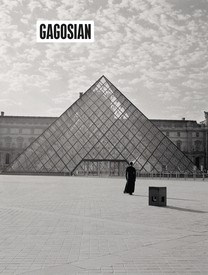
Now available
Gagosian Quarterly Summer 2021
The Summer 2021 issue of Gagosian Quarterly is now available, featuring Carrie Mae Weems’s The Louvre (2006) on its cover.

Artist to Artist: Rachel Feinstein and Ewa Juszkiewicz
On the occasion of Frieze New York 2021, the two artists discuss remixing conventions, the allure of Rococo, and the importance of research and history within their respective practices.
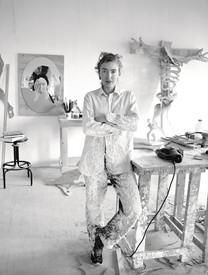
Rachel Feinstein
The artist discusses her life and work with Alan Yentob.
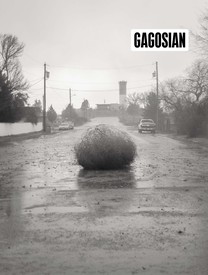
Now available
Gagosian Quarterly Winter 2019
The Winter 2019 issue of Gagosian Quarterly is now available, featuring a selection from Christopher Wool’s Westtexaspsychosculpture series on its cover.

